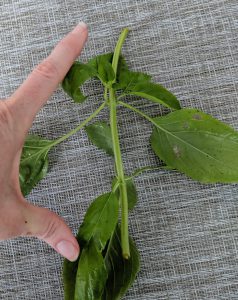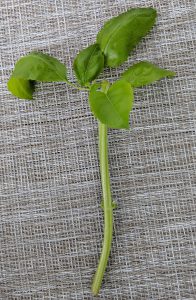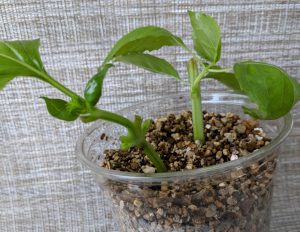Many people don’t realize that it’s easy to make copies of many plants. One of the simplest methods to get a new plant is by rooting a cutting. It doesn’t require specialized skill or equipment, and can multiply your garden quickly.
The idea behind a tip cutting is to take a part of the plant and keep it very moist so it puts out roots from the stem. This can be done by just putting a stem in water, but roots grown in water are not quite the same as those grown in soil, so the plant will sometimes die when put out in the garden. A more successful method is to plant the cutting in a moist medium such as potting soil or vermiculite. To see a quick video tutorial, click here
Cut a four to six inch piece of flexible, growing branch off of the plant. The right length for a cutting is about the distance from the tip of your index finger to your thumb when you spread your hand. It’s tempting to think a longer stem will have more energy to grow, but without roots, the plant can’t take in enough water and it will wilt. Smaller is better! Use clean, sharp pruners, as you don’t want to crush the stem when you cut it.

Figure 1. The cutting should be four to six inches long
Make sure the stem has at least one set of leaves toward the bottom. Leaves come from growth nodes, and this is where roots are most likely to form. Cut off all but the top few leaves.

Figure 2. Trim off all but the top few leaves
You need a container to plant the cutting in. A narrow, deep container is ideal. A cheap, easy cutting pot is a plastic cup. The ubiquitous red party cup just needs a couple of holes for drainage. Insert the tip of a utility knife in the bottom and give it a slight twist to open up the slit. Do this twice, and your container is ready. If you are doing several cuttings, write the type of plant and the date on the cup with a permanent marker so you know what you have later.

Figure 3. Cut a couple of holes in a plastic cup to make a perfect cutting pot.
Fill your cup with a medium that will stay moist. A good quality potting soil, peat moss, or vermiculite all work well. Poke a pencil in to make a hole and insert the cutting, making sure at least one growth node (where you trimmed off the leaves) is under the surface. Put it in full shade, such as on a covered porch. Water it well, and keep it watered for a few weeks. That’s it! You’re on your way to having a new plant.

Figure 4. Make a hole with a pencil so you don’t damage the stem

Figure 5. Plant the cuttings and keep them moist.
To see if roots are forming, give the stem a gentle tug. If it resists, there are roots, and the cutting is ready to be planted in the garden.

Figure 6. After a few weeks, roots will form. This basil is ready to plant in the garden.
Soft stemmed plants root especially well as tip cuttings. The mint family will root in just a couple of weeks – that includes herbs such as basil, oregano, thyme, and sage, as well as ornamentals like coleus and ivys. Most vines root well. And it’s a great way to get new copies of the nightshade family such as tomatoes, petunias, and calibrachoa. Remember that you will get a clone of the parent plant, so it will have the same color flowers or other characteristics. If the parent plant is diseased, your cutting will be diseased too, so start with a healthy plant.
Many trees and larger plants can also be grown from cuttings or other methods. If you’re not sure a plant is suitable for cuttings, give it a try – all you’re doing is pruning a bit of the plant, so there’s really nothing to lose. For more information on how to propagate different types of plants, see http://edis.ifas.ufl.edu/mg108.
This blog post was written by UF IFAS Extension Orange County Master Gardener, Mary Ann Pigora, class of 2017. The UF IFAS Extension Orange County Master Gardener Volunteers play a crucial role in the outreach of UF IFAS Extension.
 0
0
